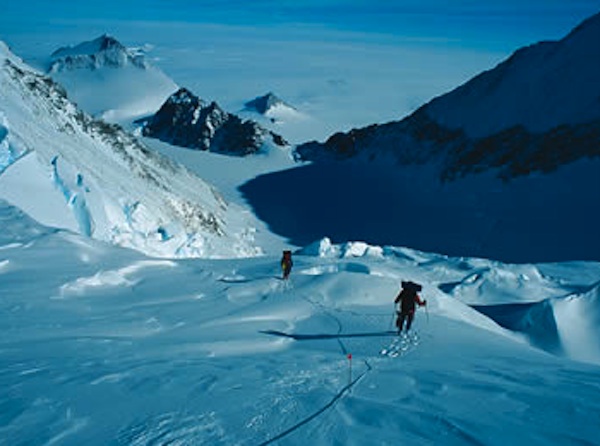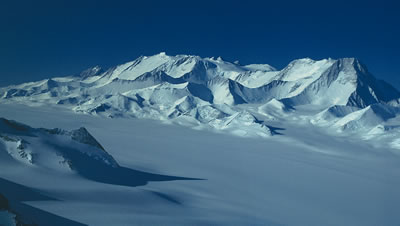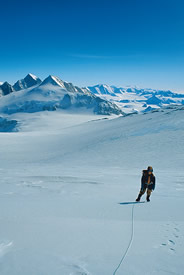Mt. Vinson Expedition
Itinerary and Route
We meet in Punta Arenas in Chilean Patagonia and then fly to a base by the Patriot Hills at 80 degrees South, called Union Glacier Camp, where there is a seasonal tent encampment and where our aircraft can make a wheeled landing on a natural blue-ice runway. We spend one night there and the next morning fly about an hour north in smaller, ski-equipped aircraft to our base camp at 7,874 feet on the Branscomb Glacier at the base of Vinson. Here we will review the Leave No Trace techniques that we will be using, go over crevasse rescue and glacier travel procedures, and do the final organizing of our gear.
The climb involves interesting glacier travel on the wide and gently sloping lower reaches of the Branscomb Glacier. We pull our sleds up the glacier far below the impressive ice falls that cascade from the main Vinson plateau, 1,500m/5,000ft above.
The Base Camp is situated on the Branscomb Glacier at approximately 2,100m/6,900ft and we use two higher camps at approximately 2,700m/8,850ft and 3,850m/12,600ft. The Low Camp is situated further up the glacier just beyond the second icefall, below an ice-wall, which drops directly from the main summit which is about a 7-hour walk from Base Camp punctuated by regular breaks to take in the scenery. We carry half of our equipment in a rucksack and the other half we tow behind on a small plastic sledge.
From Low Camp, we climb a 1,200m/4,000ft snow arête (up to 40 degrees steep) on fixed rope for approximately 800m/2,600ft. Fixed rope techniques will be taught during the expedition. The snow arête leads us to High Camp which takes about 6–9 hours. High Camp is nestled beside a rocky ridge adjacent to the main summit plateau.
The climb from High Camp to the summit normally takes between 7 and 10 hours, depending on the speed of the party. The descent back to the top camp takes around 2½ hours. On summit day as you climb the glacial plateau, you will first pass Branscomb Peak on the left and the final Vinson summit pyramid then lies directly ahead. From here we climb the picturesque East Ridge, weaving in and out of small rock steps until we arrive at the stunningly beautiful summit and the highest point on the Antarctic continent.
There is a Sierra Club book in a metal tin on the summit of the peak for those wishing to record their ascent. The descent from High Camp down to Base Camp can be achieved reasonably comfortably in one day. We collect the toilet bags and other waste on the way down the mountain.
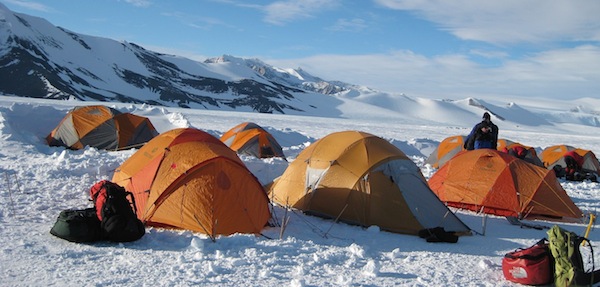
Climbing camp on Vinson. AAI/AC Collection.
Mt. Vinson Expedition
Cost and Details
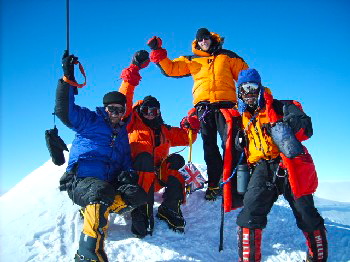
January 2007 team on the summit of Vinson.
Luis Benitez
Max Ratio - 10 climbers with 2 guides
Capacity - 10 climbers
Duration - 16 days
Cost - $44,250
2022/2023
Climbing Season
Expedition Inclusions and Exclusions
Inclusions:
- Flights to and from Union Glacier in Antarctica
- Flights from Union Glacier to Vinson Massif base camp and return
- Professional Mountain Guides' services
- All expedition organizational requirements
- Tents and group cooking equipment
- Group climbing equipment
- Use of expedition satellite phone for outgoing calls
- Dispatch webpage updated throughout the trip for friends and family to follow
- Transport of 50 lbs (23 kg) of personal equipment
Exclusions: Air travel to and from Punta Arenas, Chile; Hotel and meals in Punta Arenas; visa and airport fees; personal insurance - full travel, trip cancellation, medical, and rescue insurance is required. Medical evacuation insurance coverage of US$150,000 is required; personal clothing and equipment; excess baggage transport charges of US$77 per kg for any baggage exceeding the personal equipment weight limit; cost of satellite phone call while on the expedition.
The AAI / Adventure Consultants Alliance
The American Alpine Institute strives to provide the highest quality service and leadership to our climbers around the world. On certain expeditions, we reach out to our partners to combine resources and offer an experience unmatched by any other guide service. This is a joint expedition with Adventure Consultants who maintains the same standards for excellence as AAI.
History on Vinson Massif
Rob Hall and Gary Ball, the founders of Adventure Consultants, ran their first commercial expedition to Vinson Massif in December 1992. They worked together with Adventure Network International (ANI) whom they had established a relationship with in 1990 for the Vinson climb that completed their “Seven Summits in Seven Months” project. Rob had already climbed the mountain in 1989 as a field assistant to geologists Ed Stumps and Paul Fitzgerald; theirs was a United States Antarctic Research Program expedition that also included Ed’s brother Mugs, an accomplished American alpinist.
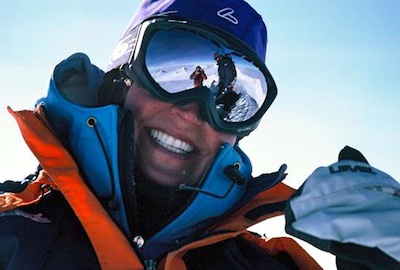
Antarctic wilderness reflected in a climber's goggles on Vinson. Guy Cotter
Vinson and most of the other high Ellsworth peaks were first climbed in 1967 by American alpinists supported from McMurdo Station by the United Sates government program.
Giles Kershaw was a veteran polar pilot who during the 1980’s pioneered landing large wheeled aircraft on natural ice runways. He founded ANI and established a tent camp at Patriot Hills, accessed by DC6 aircraft flying direct from Punta Arenas. This made the Ellsworth Mountains accessible to private adventurers.
AAI and Adventure Consultants have continued to take advantage of the relative accessibility of Patriot Hills (now called Union Glacier) to stage Antarctic expeditions including ascents of Vinson Massif. The 2019/2020 expeditions mark the 26th season of guiding on Vinson for Adventure Consultants.
Mt. Vinson Expedition
FAQs
- I have heard that there can be long delays trying to get to, or get back from the ice, is this true?
- How can I best prepare for the cold? Isn’t it the coldest place on the planet?
- After going all that way, I would like to stay and go to the South Pole, is this possible and if so, how long would it take?
- Can I use skis on Vinson?
- If we get “stuck” on the ice, what do we eat? Have you ever run out of food?
- Why is this 2 week trip so expensive???
- What are the skills/prior experience required for this climb?
- What is the conditioning level needed for this climb?
- How many climbers will be on this expedition?
- Can I contact other climbers or guides for this expedition?
- Will I be sharing a tent or room with other climbers? Is a single supplement available?
- How heavy will my pack / sled be?
- What kind of food do you have on the mountain?
- How long is a typical day on the mountain?
- What type of communication is available on the climb?
- What sort of hotels do we stay at in the city?
- What time should I arrive and where do I meet my guides?
- What if I arrive early or depart late?
- How much should I budget for this expedition? How much cash should I plan to bring?
- How much should I tip my guide staff?
- Are there any entry or visa requirements?
- Can't find your question here?
1. I have heard that there can be long delays trying to get to, or get back from the ice, is this true?
Sometimes this is true and other times the trip goes to schedule though often there is some sort of delay on most trips as we wait for suitable weather conditions for flying in and out of Antarctica. Even though our expeditions are only 2 weeks long, you MUST purchase an open, fully changeable air ticket, as trips can be extended by a week or more. Given the remote nature of where we are landing, both at base camp and at Union Glacier, the weather must fall within certain parameters to be able to fly and you can be assured the reasons for flight delays are for safety. In today’s world there are few places where the environment still affects our plans and Antarctica is one of them!
2. How can I best prepare for the cold? Isn’t it the coldest place on the planet?
Yes, if the wind picks up and you are in the shade, it can get very cold indeed. The good part is that it is a dry cold. Low humidity makes the low temperatures a bit more tolerable. The best way to prepare for these temperatures, barring standing in a walk in freezer, would be to get out during the winter months if you can, and anticipate how your body will respond to the change in climate. To give you an idea of just how cold places down there get, the lowest ever recorded temperature by humans was at Vostok on July 21, 1983 was -128 F (-89C)!
3. After going all that way, I would like to stay and go to the South Pole, is this possible and if so, how long would it take?
We can arrange this for you. It typically takes 10 days or so after your climb is finished. The whole team flies back to Union Glacier, and when the main group flies back to South America, you will fly to 88 nautical miles away from the pole, and ski the rest of the way in pulling sleds just like the polar explorers! See our Ski the Last Degree South Pole page. Note, this option is only available after our first, second or third departures, as it is getting too late in the season to do this after our January departure.
4. Can I use skis on Vinson?
On the mountain, we actually don’t need them! We typically do not wear skis on our expeditions, as skiing with a heavy pack and a sled behind you is a skill most do not have.
5. If we get “stuck” on the ice, what do we eat? Have you ever run out of food?
No, we won’t run out of food! Typically we bring at least one weeks worth of extra food with us. If we are required to stay longer than this we will then dine at the large base operated from Union Glacier, who maintain huge stores of food that could basically winter over everyone present.
6. Why is this 2 week trip so expensive???
One sentence sums it all up. The flight to and from the ice. This will be the most expensive, no frills flight you will ever take. The plane is a Russian built Ilyushin 76, designed for work in Siberia; it is well suited for taking off and landing on the ice. However, the interior will be jammed with cargo for the base, our gear, climbers, scientists, polar explorers, etc. Despite the low frills, it is a fun and exciting flight, especially the landing!
7. What are the skills/prior experience required for this climb?
We usually ask that you have prior experience with an ice axe and crampons, and have done other remote climbs. Snow camping and previous experience at altitude would also be beneficial.
8. What is the conditioning level needed for this climb?
Given the remote location and altitude, we ask that you are in good condition. Cardiovascular shape is very important on this climb, as the summit day can be long. You need to be able to carry a pack between 30-45 lbs/14-20 kg and drag a sled 20-30 lbs/9-14 kg.
9. How many climbers will be on this expedition?
Typically ten members is our maximum with two guides or five climbers with one guide.
10. Can I contact other climbers or guides for this expedition?
Sure! Before the expedition, contact our office and we can pass on your details to the other climbers.
11. Will I be sharing a tent or room with other climbers? Is a single supplement available?
Typically you have your own hotel room in Punta Arenas and share a tent on the mountain with one other member.
12. How heavy will my pack / sled be?
Expect your pack to be 30-40lbs/14-18kg on the way up and 40-45lbs/18-20kg on the way down. Your sled will be about 20-30lbs/9-14kg on the way up, and 20-25lbs/9-11kg on the way down.
13. What kind of food do you have on the mountain?
Quite tasty stuff! Given that we are living in a walk in freezer, we bring such things as steak, fresh fruit and veggies, salmon, etc. to keep stored at basecamp for before and after our climb. On the mountain we also eat fresh food plus MRE’s -Meals ready to eat. This is real food, vacuum sealed, so you just heat and eat! We can also cater for different dietary requirments.
14. How long is a typical day on the mountain?
Typically expect your days to be 4-9 hours long, with summit day potentially being longer.
15. What type of communication is available on the climb?
Your guides will carry satellite phones, which you are welcome to use for a nominal fee. Contact the office for details.
16. What sort of hotels do we stay at in the city?
The expedition departs from Punta Arenas and we stay at a great little hotel called Terra Del Fuego or at a more upmarket hotel called Hotel Rey don Felipe. The hotel staff are good friends of our company and they go out of his way to make us all feel at home and welcome. The challenge for hotels in town is if we need to extend our stay due to not being able to leave for the ice on our specified departure date. Many groups actually get kicked out of their hotel, but with us, Patricio actually works hard to be able to keep us in the hotel till our departure!
17. What time should I arrive and where do I meet my guides?
Before the start of your expedition, you will receive a final details letter from the office outlining when and where you will be meeting your guides.
18. What if I arrive early or depart late?
We can assist you with booking extra hotel room nights if you arrive early. However, on this trip YOU ARE NOT ABLE TO ARRIVE LATE, as sometimes we can fly to the ice the day after your arrival, and if that is the case, and your bags get lost, you will not be able to come on the expedition.
19. How much should I budget for this expedition? How much cash should I plan to bring?
Given the unsure nature of the start of the trip, it is difficult to say how much cash to bring. We usually suggest that members bring a cash card with them, as there are many international cash machines in Punta Arenas.
20. How much should I tip my guide staff?
This all depends on your level of interaction with your guide. If you feel that your guide did their best to make your trip a great experience, give accordingly.
21. Are there any entry or visa requirements?
It all depends on what country you are coming from. Please click on the attached link for details: www.worldtravelguide.net/chile/passport-visa.
22. Can't find your question here?
Contact our office for further information!
